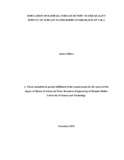SIMULATION OF RAINFALL SURFACE RUNOFF- WATER QUALITY EFFECTS ON SURFACE WATER BODIES IN MID-BLOCK OF YALA
Abstract
In Kenya and other countries in the world, most water treatment works derive their raw
water from rivers that flow in a watershed. Lack of proper management of watershed leads
to high runoff generated and subsequent flooding downstream leading to damaged
infrastructure, pollution and deterioration of water quality. The main aim of this study was
to simulate runoff water quality effects and establish a relationship models in three water
sheds in Yala basins. The river watersheds considered were: Edzava River, Zaaba River
and Garagoli River which are in Vihiga County, Kenya. ArcGIS software was used to
delineate the watersheds and from the DEM Edzava watershed covered an approximate
area of 152km2 with a longest length of 32.344km, Zaaba Water shed covered an
approximate area of 79.51km2 with a longest length of 9.423km and Garagoli Watershed
covered an approximate area of 34.04km2 with a total longest length of 17.118km.
Artificial Neural Networks (ANN) model in MATLAB was used for simulation with input
data being runoff generated from precipitation and output data was water quality
parameters (Turbidity, Color, TDS pH and Iron) which were historical data from the year
2008 to 2017, a period of 10 years. The runoff generated in the three river watersheds had
high values in April-May and September- October in each year. The results established
that turbidity registered the highest values of 462 NTU and colour 1062 FTU in Edzava.
TDS had high values in November to January and had an inverse relationship with runoff.
Iron and pH did not have substantive response. ANN simulated model results had physical
parameters i.e. turbidity and colour performing well in the three watershed while TDS best
fit was in one water shed. The performance of the last two chemical parameter i.e. Iron
and PH was very low in all the water sheds and did not respond well to simulated
relationship matrix. Garagoli registered high performance for both turbidity and colour
with coefficient of correlation, R >0.8. It was only in Zaaba that TDS registered R >0.7
for training, validation and testing. From the results of this study, this model could be used
for two parameters that performed well particularly turbidity and colour and provides
useful tool for planning of surface water management, water supplies and a general
watershed management. The best practices in catchment and watershed management
should be adopted.

